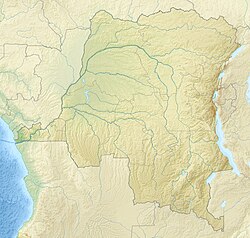Location
The Ruki is a major river in the Cuvette Centrale of the middle Congo River basin. The watershed covers about 14,000,000 square kilometres (5,400,000 sq mi). The drainage basin is almost entirely pristine lowland forest and swamp forest. As of 2020, 248 species of fish had been identified in 26 families. The main rivers are the Ruki-Busira, Momboyo-Luilaka, Tshuapa, Lomela and Salonga. The most important town in the river basin is Boende on the Tshuapa, 29 kilometres (18 mi) upstream from where it joins the Lomela to form the Busira.
The Ruki River forms above Ingende where the Momboyo River joins the Busira River from the left and flows in a west-northwest direction. It enters the Congo from the east, flowing past the north of the town of Mbandaka. The Ruki and its main tributary the Busira can be navigated year round, since the depth is always more than 1 metre (3 ft 3 in) and reaches 2 metres (6 ft 7 in) in the flood period. High water is in March-April and November. Low water is in February and June-July.
The Ruki itself is just 103 kilometres (64 mi) long, and extends downstream from the mouth of the Momboyo, which is 2 kilometres (1.2 mi) above Ingende. Higher up it is called the Busira as far as the confluence of the Tshuapa and the Lomela. The Busira section is 305 kilometres (190 mi) long, and the whole Ruki-Busira waterway is 408 kilometres (254 mi) long. The Ruki-Busira receives four navigable tributaries: the Momboyo at 103 kilometres (64 mi) from its mouth, the Salonga at 233 kilometres (145 mi), just upstream from Lotoko, and the Tshuapa and Lomela which converge to form the river.
This page is based on this
Wikipedia article Text is available under the
CC BY-SA 4.0 license; additional terms may apply.
Images, videos and audio are available under their respective licenses.

